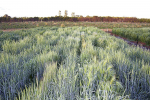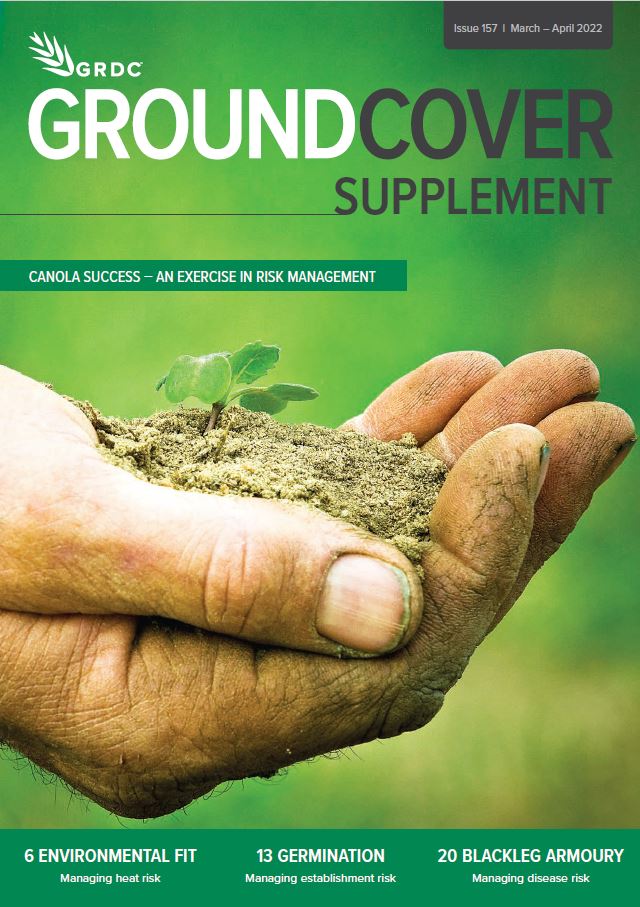This page shows the articles in of GroundCover.
GroundCover is also distributed every two months via mail. If you would like to subscribe to receive the hardcopy magazine, visit our subscription page.
Download supplement-

Canola being set to beat the heat
Supplement: Canola Agronomy, March-April 2022 - 2022-03-26T09:00:00+11:00Using controlled environment facilities at the University of Western Australia, portable heat chambers in field trials at NSW Department of Primary Industries, together with national multi-environment field trials, researchers are paving the way for the breeding and adoption of heat-tolerant germplasm in growers’ fields. This GRDC-supported research is aimed at providing promising germplasm and breeder-friendly screening procedures to accelerate the future breeding and commercial release of heat tolerant varieties. The prototype pre-breeding facility for heat stress tolerance can be incorporated into commercial canola breeding programs.
-

Water-nitrogen interactions could lessen late-season weather risks
Supplement: Canola Agronomy, March-April 2022 - 2022-03-24T09:00:00+11:00Decision-making for sowing canola must take into account the risk of drought, heat and frost during flowering. To better inform this decision-making, a multidiscipline NSW DPI team is taking a close look at water and nitrogen-use dynamics during the critical flowering period using semi-controlled environments.
-

Dual-purpose canola: from inspiration to impact
Supplement: Canola Agronomy, March-April 2022 - 2022-03-21T09:00:00+11:00A CSIRO impact assessment case study has determined that dual-purpose canola is now adopted on approximately 200,000 hectares and increasing across all southern states, with impact on profitability, sustainability and resilience and an estimated value since 2007 of $1 billion to date – growing at $200 million per annum. This impressive impact is the result of 17 years work by a committed research team involving CSIRO, growers and advisers and in late 2021 the team was recognised with the Sir Ian McLennan Impact for Science and Engineering Medal.
-

Mobile shelters create a controlled frost laboratory
Supplement: Canola Agronomy, March-April 2022 - 2022-03-19T09:00:00+11:00Commercially relevant in-field frost research is being improved with the development of mobile frost-exclusion shelters through co-investment by NSW Department of Primary Industries and GRDC.
-

HRZ canola canopy manipulation
Supplement: Canola Agronomy, March-April 2022 - 2022-03-18T09:00:00+11:00Using agronomic management techniques such as increasing plant density, nitrogen and sulfur inputs and grazing to manipulate harvest index in the high-rainfall zones, research has shown that the biomass of canola can be increased but the harvest index is harder to change. From the first year of this research growers are recommended to seek canola varieties with stable harvest index.
-

Canola looks less risky through a longer lens
Supplement: Canola Agronomy, March-April 2022 - 2022-03-16T09:00:00+11:00To bolster canola’s role as the profit driver of many cropping sequences, farming systems research in central and southern NSW is determining the optimum position of canola a sequence. The first three years of research is showing in dry years legumes saved water to shore up canola yield, and in the wet years to sure up nitrogen supply.
-

Advanced genomic model to drive canola decision support
Supplement: Canola Agronomy, March-April 2022 - 2022-03-14T09:00:00+11:00Crop process modelling, agronomy, genomics, phenomics and machine learning expertise across CSIRO is being put to the task of powering up a decision support tool for growers to better match canola varieties to production environments. This will be a valuable tool to better manage extreme heat and frost risks and improve canola productivity.
-

Canola record offers broad lessons
Supplement: Canola Agronomy, March-April 2022 - 2022-03-13T09:00:00+11:00Although producing a 7.16-tonne-per-hectare canola crop may be unattainable for many growers, the keys to its success are relevant for all looking to improve canola productivity.
-

GRDC invests in lifting canola reliability
Supplement: Canola Agronomy, March-April 2022 - 2022-03-12T09:00:00+11:00Production risks for canola in Australia are complex and include climate, weeds, pests and diseases. To support growers with their canola production, GRDC is constantly reviewing and anticipating these risks and investing with research partners to provide up-to-date management tools for growers to identify and mitigate these risks.
























































